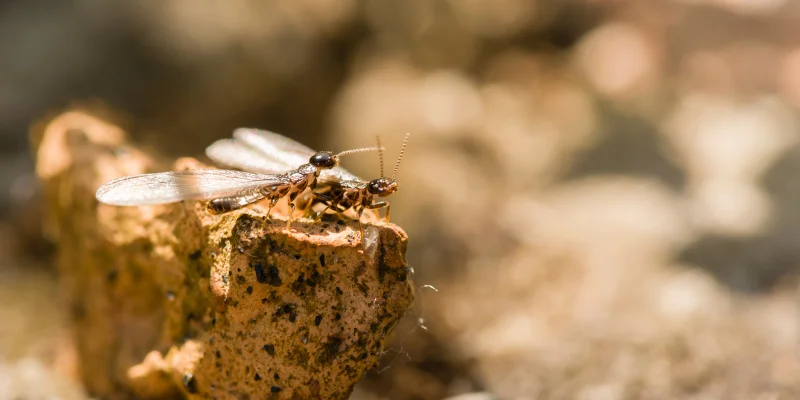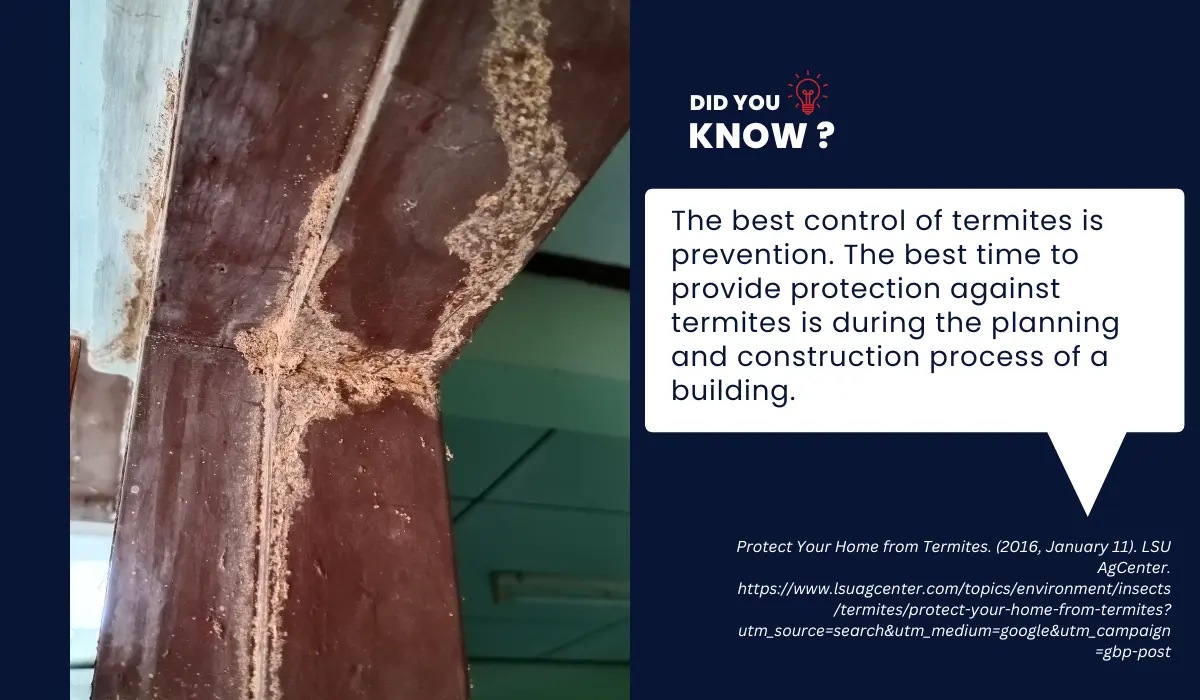
Termites are sneaky, chewing through your home without you noticing, leading to costly fixes.
Watch for early signs like discarded wings, mud tubes, hollow-sounding wood, or the quiet clicking sounds they make. Catching these signs early can save your home from big damage.
Keep your home safe by staying alert to these signs. Want to know more? Keep reading to learn how to spot and stop termites.
Key Takeaways
- Mud tubes and termite droppings are critical early warning signs of termite infestations, indicating the presence of subterranean and drywood termites, respectively.
- Other subtle signs of potential termite activity include discarded piles of wings, hollow-sounding wood, cracks in paint, and damage that mimics water damage.
- Preventing termite infestations involves eliminating food sources and moisture, using physical barriers and treated wood, and conducting regular inspections and professional treatments.
- If you spot signs of termites, avoid disturbing them and contact professional termite control services to prevent further damage to your property.
EARLY WARNING SIGNS OF TERMITES
Termites can cause extensive damage to properties if not detected early. Promptly recognizing these early warning signs of a termite infestation can help prevent costly damage.
Termite Mud Tubes
Mud tubes are a definite indication of a subterranean termite infestation. These pencil-sized tunnels shelter termites as they move between their colony and food source.
What to Do Next
While mud tubes alone don’t cause damage, they enable worker termites to carry out their destruction, so your next step is crucial.
- Inspect your home’s foundation walls and other concrete surfaces visually.
- Search for raised tunnels that have a muddy appearance.
- Tap the tubes to feel their consistency; active tubes are typically moist.
Termite Droppings
Termite droppings, feces, or frass are tiny, dark, and pellet-shaped. Residents often describe the appearance as similar to sawdust or coffee grounds.
They are found near infested wooden structures, windowsills, and doorframes.
What to Do Next
The presence of frass is usually the first sign of a drywood termite infestation. Here’s what you can do when you find one:
- Inspect the area around the frass for other signs of termite activity, such as hollow-sounding wood, visible tunnels, or the termites themselves.
- Avoid cleaning up the frass immediately before a professional inspection; its location can help termite control experts determine the infestation’s extent and entry points.
- Contact a professional termite inspection service to assess the situation and recommend a course of treatment.
Other Early Signs of Termite Activity
Early detection goes beyond the obvious signs. As homeowners, you may encounter subtle indicators of an infestation.
| Other Signs of Termites | Details |
| Discarded Piles of Wings | Remnants of termite wings near closed windows, doors, and other home-entry points. |
| Hollow-sounding Wood | Wood that sounds empty when tapped could mean termites are feasting within. |
| Cracks on Paint | Unexplained cracks on painted surfaces might hide termite activity. |
| Wood Damage | Areas where drywood termites have compromised the wood, which often sounds hollow when tapped. |
| Tiny Kick Out Holes | Drywood termites create these small openings in hardwood, which are a subtle hint of an infestation. |
| Water Damage-Like Appearance | Termite damage can often mimic the look of water damage. |
| Honeycomb Indents | Visible in baseboards, this damage pattern is distinctive to termite infestations. |
| Splintering Wood Beams | Wood beams may start to splinter when termites feed, weakening structural integrity. |
| White-winged Insects | These inside your home usually mean a termite swarm has occurred or is imminent. |
HOW TO INSPECT FOR TERMITE DAMAGE
Various types of termites, such as dampwood termites, can silently undermine a structure’s integrity.
Recognizing the early signs of termite damage is crucial for homeowners to prevent extensive harm.
Bubbling Paint and Damaged Wood
Termites often leave subtle clues behind. Bubbles in paint or areas where the wood feels unusually soft are telltale signs of termite infestations.
To inspect for significant damage beneath the surface:
- Look for areas where the paint bubbles or peels without an apparent cause.
- Gently probe any suspicious areas with a screwdriver or sharp object to check for softness indicative of damaged wood.
Visible Galleries in Wood
Wooden structures in homes are prime targets for termites. The intricate, maze-like galleries they chew through the wood are not always visible.
When they are, they indicate a termite colony’s presence.
- Use a flashlight to examine wood or drywall surfaces for irregular patterns or hollowed-out channels.
- Pay special attention to areas where wood appears darker or softer.
Structural Damage in Your Home
An active termite infestation can lead to dire consequences for the structural integrity of your home.
- Inspect the stability of wooden support beams by feeling for areas that give way under pressure.
- Examine floorboards for sagging or bouncing, which could hint at a compromised foundation beneath.
- Check door frames for small holes or crumbling wood, which could be exit holes from termite activity.
TERMITE PREVENTION TIPS

Preventing termite infestations involves a strategic approach to eliminate attractants and fortify the home against attack.
These key strategies help you protect your property from different termite species.
Eliminating Food Sources and Moisture
To deter termite activity, you should reduce potential food sources and moisture:
- Remove Wood-to-Soil Contact: Ensure that any wood features of the house do not touch the soil directly.
- Fix Leaks Promptly: Water leaks create moisture that termites find enticing.
- Proper Ventilation: Keep crawl spaces and attics well-ventilated to reduce humidity levels.
- Clear Stumps and Debris: Remove old stumps and debris near the home that could serve as a food source.
- Direct Water Away from the Foundation: Use downspouts and gutters to keep water from pooling by the home’s foundation.
Using Physical Barriers and Safe Wood Practices
For new constructions or renovations, consider the following options:
| Wood Treatment | Termite-Resistance | Best Used For |
| Borate-treated Wood | High | Structural framing |
| Pressure-treated Wood | Moderate to High | Decks, support beams |
| Naturally Resistant Woods | Variable (Cedar, Redwood) | Saunas, outdoor furniture |
Regular Inspections and Professional Treatment
Annual inspections by professional exterminators can spot early signs of termite problems and the formation of their new colonies.
To exterminate flying termites entirely from your home, you can check the following termite treatment options at LaJaunie’s Pest Control:
- bait stations
- tent fumigation
- no-tent termite control
- termite trenching
- termite inspection
- termite pre-treatments
Other Prevention Tips for Termite Infestation
These additional recommendations can further help you prepare for termite swarmers or alates and reduce their presence on your property:
| Other Prevention Tips | Details |
| Crushed Rock Barrier | Create a barrier of at least 12-18 inches using crushed rock between your home’s foundation and any soil or mulch to deter termites. |
| Seal Cracks and Openings | Fill in foundation cracks and around utility lines to eliminate termite entry points. |
| Prune Vegetation | Keep plants trimmed away from the house to prevent moisture buildup and termite access. |
| Store Firewood Properly | Firewood should be stored off the ground and away from the house to avoid attracting termites. |
| Monitor Mud Tunnels | Be vigilant for mud tunnels on exterior walls indicating subterranean termites’ presence. |
| AC Unit Maintenance | Repair leaky air conditioning units promptly to prevent water from pooling around your home’s foundation. |
| Wood and Debris Removal | Avoid damp or rotting wood and other debris that attract termites outside your home. |
IS IT TIME TO CALL THE TERMITE EXPERTS?
Got one or more sure signs? They’re not interior design trends; they’re maydays from your home! It’s time to call in the pest control services for a free inspection and payment terms before your house goes from cozy to crumbly.
Whether you’re in Baton Rouge or New Orleans, seeking expert help should be easy. For immediate intervention for a severe infestation, let Lajaunie’s termite control specialists tailor a solution that’s right for your home.
For more information about the areas we service, visit our location page.